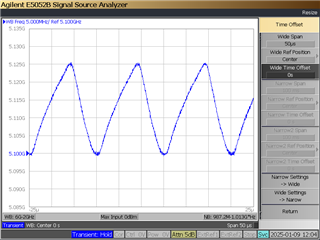Tool/software:
I am trying to generate an automatic ramp signal between 10.2 and 10.25 GHz over 5 microseconds with the LMX2595EVM. However, when I configure the ramp parameters for this waveform, I am not able to generate the desired ramp signal. However, if I change the ramp time from 5 us to 20 us, I am able to generate the desired signal. What is the maximum ramp slew rate for the LMX2595? It looks like 50 MHz over 5 us (10 MHz/us) exceeds this limit, while 50 MHz over 20 us (2.5 MHz/us) works.
Would it be possible to achieve a 50 MHz over 5 us (10MHz/us) ramp with the LMX2595 if I increase the bandwidth of the loop filter?




